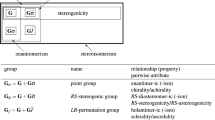Abstract
Molecules derived from a parent skeleton are enumerated where both achiral ligands as well as chiral ligands are allowed. Chirality fittingness of an orbit is proposed in order to permit chiral ligands. The enumeration is conducted with and without consideration of obligatory minimum valency (OMV). The effect of the OMV is formulated by assigning different weights to the respective orbits of the parent skeleton. The importance of coset representations and their subduction by subgroups is discussed. The subduced representations are classified into three classes through their chirality fittingness, which determines the mode of substitution with chiral and achiral ligands. Several novel concepts such as a unit subduced cycle index and a subduced cycle index are given in general forms.
Similar content being viewed by others
References
G. Pólya, Acta Math. 68 (1937)145;
G. Pólya and R.C. Read,Combinatorial Enumeration of Groups, Graphs, and Chemical Compounds (Springer-Verlag, New York-Berlin-Heidelberg, 1987);
D.H. Rouvray, Chem. Soc. Rev. 3 (1974)355;
A. Balaban (ed.),Chemical Application of Graph Theory (Academic Press, London, 1976).
E. Ruch, W. Hässelbarth and B. Richer, Theor. Chim. Acta 19 (1970)288.
W. Hasselbarth, Theor. Chim. Acta 67 (1985)339.
J. Brocas, J. Amer. Chem. Soc. 108 (1986)1135.
J.A. Pople, J. Amer. Chem. Soc. 102 (1980)4615.
C.A. Mead, J. Amer. Chem. Soc. 109 (1987)2130.
S. Fujita, Bull. Chem. Soc. Japan 63 (1990)315; see also S. Fujita, J. Amer. Chem. Soc., in press; Bull. Chem. Soc. Japan 63(1990)203.
W. Burnside,Theory of Groups of Finite Order, 2nd ed. (Cambridge University Press, Cambridge, 1911).
S. Fujita, J. Chem. Inf. Comput. Sci. 26 (1986)205;
S. Fujita, J. Chem. Inf. Comput. Sci. 26 (1986)221;
S. Fujita, J. Chem. Inf. Comput. Sci. 26 (1986)224.
S. Fujita, Bull. Chem, Soc. Japan 61 (1988)4189.
T. Oyama,Yugen Chikan-Gun (Theory of Permutation Groups of Finite Order) (Shokabo, Tokyo, 1981). [12]|For an alternative derivation and applications, see
S. Fujita, Theor. Chim. Acta 76 (1989)247;
S. Fujita, Bull. Chem. Soc. Japan 62 (1989)3771;
S. Fujita, Tetrahedron 46 (1990)365.
Author information
Authors and Affiliations
Rights and permissions
About this article
Cite this article
Fujita, S. Subduction of coset representations. An application to enumeration of chemical structures with achiral and chiral ligands. J Math Chem 5, 121–156 (1990). https://doi.org/10.1007/BF01166424
Received:
Issue Date:
DOI: https://doi.org/10.1007/BF01166424




